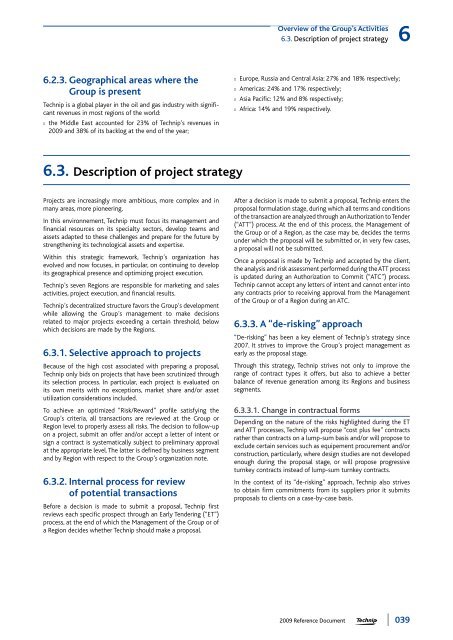Reference Document
Reference Document
Reference Document
Create successful ePaper yourself
Turn your PDF publications into a flip-book with our unique Google optimized e-Paper software.
Overview of the Group’s Activities<br />
6.3. Description of project strategy 6<br />
6.2.3. Geographical areas where the<br />
Group is present<br />
Technip is a global player in the oil and gas industry with significant<br />
revenues in most regions of the world:<br />
the Middle East accounted for 23% of Technip’s revenues in<br />
2009 and 38% of its backlog at the end of the year;<br />
Europe, Russia and Central Asia: 27% and 18% respectively;<br />
Americas: 24% and 17% respectively;<br />
Asia Pacific: 12% and 8% respectively;<br />
Africa: 14% and 19% respectively.<br />
6.3. Description of project strategy<br />
Projects are increasingly more ambitious, more complex and in<br />
many areas, more pioneering.<br />
In this environnement, Technip must focus its management and<br />
financial resources on its specialty sectors, develop teams and<br />
assets adapted to these challenges and prepare for the future by<br />
strengthening its technological assets and expertise.<br />
Within this strategic framework, Technip’s organization has<br />
evolved and now focuses, in particular, on continuing to develop<br />
its geographical presence and optimizing project execution.<br />
Technip’s seven Regions are responsible for marketing and sales<br />
activities, project execution, and financial results.<br />
Technip’s decentralized structure favors the Group’s development<br />
while allowing the Group’s management to make decisions<br />
related to major projects exceeding a certain threshold, below<br />
which decisions are made by the Regions.<br />
6.3.1. Selective approach to projects<br />
Because of the high cost associated with preparing a proposal,<br />
Technip only bids on projects that have been scrutinized through<br />
its selection process. In particular, each project is evaluated on<br />
its own merits with no exceptions, market share and/or asset<br />
utilization considerations included.<br />
To achieve an optimized “Risk/Reward” profile satisfying the<br />
Group’s criteria, all transactions are reviewed at the Group or<br />
Region level to properly assess all risks. The decision to follow-up<br />
on a project, submit an offer and/or accept a letter of intent or<br />
sign a contract is systematically subject to preliminary approval<br />
at the appropriate level. The latter is defined by business segment<br />
and by Region with respect to the Group’s organization note.<br />
6.3.2. Internal process for review<br />
of potential transactions<br />
Before a decision is made to submit a proposal, Technip first<br />
reviews each specific prospect through an Early Tendering (“ET”)<br />
process, at the end of which the Management of the Group or of<br />
a Region decides whether Technip should make a proposal.<br />
After a decision is made to submit a proposal, Technip enters the<br />
proposal formulation stage, during which all terms and conditions<br />
of the transaction are analyzed through an Authorization to Tender<br />
(“ATT”) process. At the end of this process, the Management of<br />
the Group or of a Region, as the case may be, decides the terms<br />
under which the proposal will be submitted or, in very few cases,<br />
a proposal will not be submitted.<br />
Once a proposal is made by Technip and accepted by the client,<br />
the analysis and risk assessment performed during the ATT process<br />
is updated during an Authorization to Commit (“ATC”) process.<br />
Technip cannot accept any letters of intent and cannot enter into<br />
any contracts prior to receiving approval from the Management<br />
of the Group or of a Region during an ATC.<br />
6.3.3. A “de-risking” approach<br />
“De-risking” has been a key element of Technip’s strategy since<br />
2007. It strives to improve the Group’s project management as<br />
early as the proposal stage.<br />
Through this strategy, Technip strives not only to improve the<br />
range of contract types it offers, but also to achieve a better<br />
balance of revenue generation among its Regions and business<br />
segments.<br />
6.3.3.1. Change in contractual forms<br />
Depending on the nature of the risks highlighted during the ET<br />
and ATT processes, Technip will propose “cost plus fee” contracts<br />
rather than contracts on a lump-sum basis and/or will propose to<br />
exclude certain services such as equipement procurement and/or<br />
construction, particularly, where design studies are not developed<br />
enough during the proposal stage, or will propose progressive<br />
turnkey contracts instead of lump-sum turnkey contracts.<br />
In the context of its “de-risking” approach, Technip also strives<br />
to obtain firm commitments from its suppliers prior it submits<br />
proposals to clients on a case-by-case basis.<br />
2009 <strong>Reference</strong> <strong>Document</strong><br />
039

















